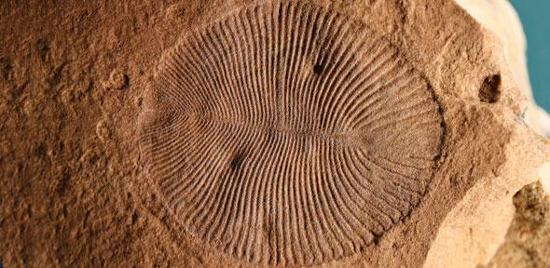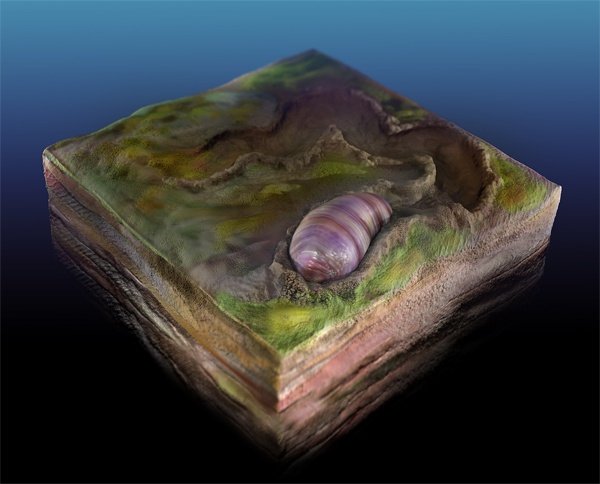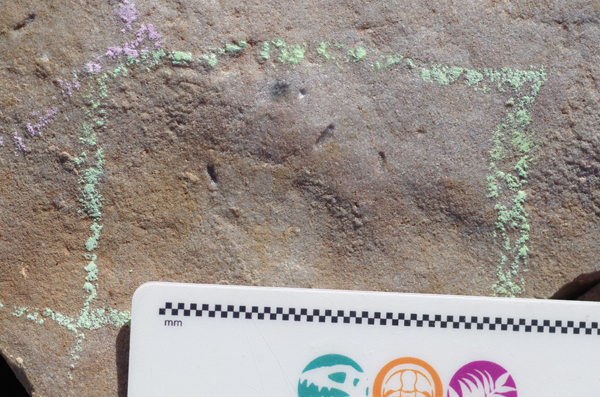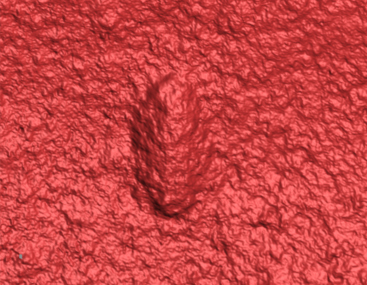Discovery of the Oldest Bilaterian – Ikaria wariootia
Meet Your Oldest Ancestor – Ikaria wariootia
A team of international scientists have identified the first ancestor of animals that show bilateral symmetry, in ancient marine sediment around 555 million years old. Palaeontologists had predicted that such an organism would be identified in Ediacaran sediments, essentially a creature with a body plan that has been adopted by the majority of the Kingdom Animalia, now thanks to the use of sophisticated three-dimensional laser scans funded by NASA, the “smoking gun” evidence has been found.
A Life Reconstruction of the Earliest Bilaterian Known to Date (I. wariootia)
Picture credit: Sohail Wasif/University California Riverside
Ikaria wariootia – The Size of a Rice Grain but a Big Discovery!
Writing in the journal “Proceedings of the National Academy of Sciences of the United States of America”, the researchers, which included scientists from University California Riverside and the South Australian Museum, examined tiny trace fossils, essentially burrows and borings into an ancient Ediacaran seabed (Ediacara Member, South Australia).
Proximal to some of these traces were very small oval impressions. Thanks to funding from a NASA exobiology grant, the team were able to employ a sophisticated three-dimensional laser scanner to map these depressions in the ancient rock. Computer-generated images revealed a worm-like organism with a cylindrical body and faintly grooved musculature. A distinct head and tail were also identified. This little animal represents the earliest bilaterian, a hugely significant step in the evolution of life on Earth.
The transition from simple, microscopic forms of life to the abundance and variety of complex creatures in the Cambrian remains quite poorly understood. However, the beautifully preserved remains of soft-bodied organisms, many of which look like nothing alive today, associated with the ancient strata of the Ediacara Hills of South Australia have permitted palaeontologists the opportunity to learn about life on our planet prior to the evolution of hard body parts such as shells and exoskeletons.
Bizarre Body Forms
Many of the creatures identified from their fossils had bizarre body forms such as the circular Dickinsonia (below), but scientists had predicted that animals with bilateral symmetry would be present in this ecosystem, it was just a question of finding them.
A Circular Impression of an Organism from the Ediacara Hills (South Australia) – Dickinsonia costata Fossil

Picture credit: Dr Alex Liu (Cambridge University)
The Development of Bilateral Symmetry
The development of bilateral symmetry was a critical step in the evolution of animal life, giving organisms the ability to move purposefully and a common, yet successful way to organise their bodies. In the scientific paper, the research team describe Ikaria wariootia as ranging in size between 2 and 7 millimetres in length and being around 1 to 2.5 millimetres wide. The largest specimens were about the size of a grain of rice, just the right size to have made the burrows and borings (trace fossils).
The discovery of Ikaria wariootia is consistent with predictions based on modern animal phylogenetics, that the last ancestor of all bilaterians was simple and small and represents a rare link between the Ediacaran and the subsequent record of animal life. Put simply, I. wariootia is on the same part of the animal family tree as the majority of animals alive today and that includes us (Homo sapiens).
Ikaria wariootia Impressions Preserved in Ancient Marine Sediment
Picture credit: Droser Laboratory/University of California Riverside
Commenting on the significance of the discovery, one of the authors of the scientific paper, Scott Evans (University of California Riverside), stated:
“We thought these animals should have existed during this interval [Ediacaran], but always understood they would be difficult to recognise. Once we had the 3-D scans, we knew that we had made an important discovery.”
Examining Ediacaran Trace Fossils
Analysis of modern animals and Ediacaran trace fossils predicted that the oldest bilaterians would be very small with simple body plans. The research team found that the size and shape of Ikaria matched the predictions that had been made with regards to the maker of the trace fossil Helminthoidichnites, indicating sediment displacement and purposeful animal movement.
Importantly, in the Ediacara Member, Helminthoidichnites occurs stratigraphically below classic Ediacara body fossils such as Dickinsonia. Together, these suggest that Ikaria represents one of the oldest total group bilaterians identified to date, with very little deviation from the characters and traits predicted for their last common ancestor.
In addition, these trace fossils persist into the Phanerozoic Eon (from the Cambrian Period onwards), providing a critical link between the Ediacaran and Cambrian biota.
A Three-Dimensional Laser Image of a Scan of a Rock Depression Revealing the Body Plan of Ikaria wariootia
Picture credit: Droser Laboratory/University of California Riverside
What’s in a Name?
The genus name comes from Ikara, which means “meeting place” in the local Adnyamathanha dialect. It is the Adnyamathanha term for a grouping of mountains known as Wilpena Pound. The trivial name comes from Warioota Creek, which runs from the Flinders Ranges to Nilpena Station in the Ediacara Hills. It may look a fairly simple animal to us, but back in the Ediacaran Ikaria was one of the most complex organisms around. It burrowed in thin layers of well-oxygenated sand on the ocean floor in search of organic matter, indicating rudimentary sensory abilities.
The depth and curvature of Ikaria represent clearly distinct front and rear ends, supporting the directed movement found in the burrows. The walls of the burrows preserve evidence of “v-shaped” ridges, which indicate that Ikaria moved by contracting muscles across its body like an earthworm. This is known as peristaltic locomotion.
Everything Dinosaur acknowledges the assistance of a media release from the University of California Riverside in the compilation of this article.
The scientific paper: “Discovery of the oldest bilaterian from the Ediacaran of South Australia” by Scott D. Evans, Ian V. Hughes, James G. Gehling and Mary L. Droser published in the Proceedings of the National Academy of Sciences of the United States of America.
The Everything Dinosaur website: Everything Dinosaur.




